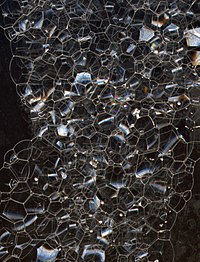
Pressure amplification effect of using resorcinol/formaldehyde foam ablators in laser-shock experiments
Sign Up to like & getrecommendations! Published in 2021 at "Physics of Plasmas"
DOI: 10.1063/5.0048651
Abstract: Resorcinol/formaldehyde (RF) foam-aluminum-quartz-layered targets were shock compressed up to 0.9 TPa in quartz to quantitatively evaluate the pressure-amplification effect of using a low-density RF foam as an ablator. The velocimetry and pyrometry were used to… read more here.
Keywords: pressure; foam; formaldehyde foam; resorcinol formaldehyde ... See more keywords

[PP.19.33] INVASIVE AORTIC PRESSURES IN AN ARAB POPULATION- IMPACT OF AGE & GENDER
Sign Up to like & getrecommendations! Published in 2017 at "Journal of Hypertension"
DOI: 10.1097/01.hjh.0000523723.56383.69
Abstract: Objective: While pulsatile hemodynamics is well-established as independent prognosticator in various ethnic populations, currently there are no data on these important measures in an Arab cohort. Methods: We performed retrospective analyses on invasive central aortic… read more here.
Keywords: age; pressure amplification; age gender; pulse pressure ... See more keywords

ATTENUATION OF PULSE PRESSURE AMPLIFICATION IN ELEMENTARY SCHOOL-AGED PATIENTS WITH COMPLETE TRANSPOSITION OF GREAT ARTERIES AFTER ARTERIAL SWITCH OPERATION
Sign Up to like & getrecommendations! Published in 2018 at "Journal of Hypertension"
DOI: 10.1097/01.hjh.0000539561.56308.ac
Abstract: Objective: We previously reported damaged distensibility of ascending aorta in patients with complete transposition of great arteries after an arterial switch operation (ASO). It resulted in increase of pulse pressure in ascending aorta. Therefore, we… read more here.
Keywords: pressure amplification; pulse pressure; complete transposition; pressure ... See more keywords

Relationships between serum free fatty acid and pulse pressure amplification in overweight/obese men: insights from exercise training and dietary modification
Sign Up to like & getrecommendations! Published in 2018 at "Journal of Clinical Biochemistry and Nutrition"
DOI: 10.3164/jcbn.17-103
Abstract: Pulse pressure amplification (i.e., the ratio of peripheral to central pulse pressure) is a strong predictor of cardiovascular events. Circulating free fatty acid, which is a major cause of insulin resistance, has been reported to… read more here.
Keywords: fatty acid; free fatty; pressure amplification; pulse pressure ... See more keywords

Estimating Central Pulse Pressure From Blood Flow by Identifying the Main Physical Determinants of Pulse Pressure Amplification
Sign Up to like & getrecommendations! Published in 2021 at "Frontiers in Physiology"
DOI: 10.3389/fphys.2021.608098
Abstract: Several studies suggest that central (aortic) blood pressure (cBP) is a better marker of cardiovascular disease risk than peripheral blood pressure (pBP). The morphology of the pBP wave, usually assessed non-invasively in the arm, differs… read more here.
Keywords: methodology; pressure; pressure amplification; blood ... See more keywords